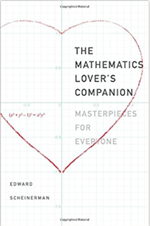'The mathematics lover's companion'

The mathematics lover's companion: Masterpieces for everyone
by Edward Scheinerman
This book is a well-organised and friendly exploration of some of the most beautiful and significant results in mathematics. It's a collection of important mathematical theorems and concepts that everyone can understand and learn to appreciate, irrespective of their scientific or mathematical background.
The book is divided into twenty-three chapters, each falling under one of three main categories: number, shape and uncertainty. There is also a preface that includes Scheinerman's suggestions on how this book should be read, as well as a prelude describing the concepts of theorem and proof in mathematics. The first twelve chapters are devoted to numbers, and they range from concepts such as irrational, Fibonacci, transfinite and imaginary numbers to specific well-known mathematical constants such as π and Euler's e. The next six chapters study shapes in mathematics, starting with familiar Euclidean triangles and circles and progressing towards more exotic and perhaps less intuitive shapes such as the Sierpinski triangle, which exists between dimensions, and the hyperbolic plane, which fits entirely within a disk. The final five chapters deal with uncertainty, and they include chaos theory, probabilities and a fascinating game called Newcomb's paradox, which manages to incorporate the effects of free will into a mathematical problem.
The subtitle "Masterpieces for everyone" is appropriately chosen, because the book truly contains mathematical masterpieces that everyone can understand. The only prerequisite is high school algebra. And given the thematic variability of the chapters and their self-containment, it is easy for readers to find something in this book that they will enjoy reading about, and even skip chapters that they might find less interesting. From my experience reading this book, though, I would recommend against this strategy. Even if one of the topics might seem unappealing to a reader, Scheinerman often includes real-world applications, witty comments and interesting asides that might prove the reader's expectations quite wrong. For example, the chapter on the irrationality of the square root of two might sound too abstract to some readers or all too familiar to others, but it includes a beautiful application to instrument tuning and the connection between irrational numbers and harmonic sounds, which many might find interesting and surprising.
Even though the basic goal of this book is to present mathematical masterpieces in a way that everyone can understand, it aspires to do much more than that. Its ultimate purpose is to guide the reader from being able to simply follow the results presented to learning to appreciate their significance and mathematical elegance. Naturally, most mathematicians and people who already have a good understanding of mathematics have an edge here. If you fall into this category and already have a deeper appreciation of mathematics, this book is still a very enjoyable read because it will remind you why you fell in love with mathematics in the first place.
But where Scheinerman's skills as an educator truly shine is in guiding readers who have an interest in mathematics but not necessarily much experience with it. Sadly mathematics is often taught in a dry and uninspiring way at school, usually with an emphasis on memorising formulas and solving equations without any real motivation. This book focuses instead on the analytical thinking approaches and intuition behind famous mathematical results. Its very first chapter is a proof by contradiction that there exist infinitely many prime numbers. This deceptively simple proof relies entirely on logic and high-school algebra, which is surprising for a theorem that Scheinerman (as well many other mathematicians) consider one of the most significant and beautiful results in all of mathematics.
As Scheinerman points out in the preface, however, it can be difficult to teach someone the joy of something until they experience it themselves. With that in mind, he offers various short problems throughout the book for the readers to solve, and of course provides all the answers in subsequent pages. The result is a book which can easily transform into a series of intellectually challenging mathematical exercises and puzzles, all done under the guidance of someone who clearly has a passion for mathematics and perhaps an even bigger passion for teaching it.
The mathematics lover's companion lives up to its title. Readers already well-versed in mathematics will be taken back to the first time they were left in awe by Euler's equation or their first attempt to wrap their head around all the different kinds of infinity — but Scheinerman's humorous and witty style, as well plenty of enjoyable asides, will make reading the book worthwhile. To readers who are interested in mathematics but not yet very familiar with it, this book offers a fun tour into the world of mathematics.
- Book details:
- The mathematics lover's companion: Masterpieces for everyone
- Edward R. Scheinerman
- hardback — 296 pages
- Yale University Press (2017)
- ISBN 978-0300223002
About the author
Veni Karamitsou is a PhD student in applied mathematics at the University of Cambridge. She is a member of the Disease Dynamics Group, and is currently working on modelling how the influenza virus evolves and spreads.